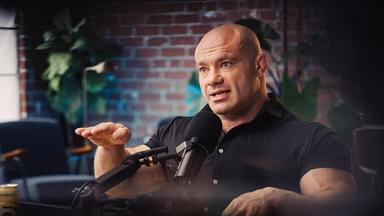In the realm of fitness, most gym goers are willing to endure soreness and restrictions of food for their dream physique. However, while hitting the gym for hours and going for higher reps might seem to be the solution for faster muscle growth for rookies, it isn’t usually the case. Dr. Mike Israetel has always focused on technique when it comes to strength training, and recently on the Renaissance Periodization YouTube Channel, he suggested five ways to gain muscle but with less weight.
However, there’s always an ideal form of all exercises, and Dr. Mike wants his followers to focus on that, as it will effectively aid muscle growth. There are also five core elements that the exercise scientist shares, which include:
- Deep ROM
- Controlled eccentric
- No cheating
- Make your target the limiting factor
- Easy on joints
Dr. Mike’s Focus on a Deep Range of Motion
Deep ROM, or deep range of motion, refers to the most stretched position for the muscle group being trained. However, those who avoid the ultimate stretch of their muscles during any type of exercise are missing out on significant muscular growth. Dr. Mike goes on to say that employing a lighter load or weight allows the user more room for movement while also making individuals less fatigued and reducing the danger of injury. Moreover, there are additional benefits to deep ROM, as he says:
“Because you’re taking your muscles through a super big range of motion and putting them into kind of interesting flexibility positions, you expand your mobility, flexibility, athletic ability and reduce your overall future injury risk from any kind of activity.”
The exercise scientist describes a situation in which a person who commits to exceptionally deep sumo squats slips on ice and has no effect on their body since the specific muscle group is already used to certain positions. However, those who do not follow the aforementioned exercise risk injuring themselves because their bodies are not strong enough to withstand extreme situations.
Controlled Eccentric
The controlled eccentric or lowering phase of a workout is where the muscles undergo lengthening while they contract. However, an individual might face a couple of issues if they do not control their eccentric. The first one emphasizes that the individual will have less muscular gain than those who strictly follow the aforementioned strategy. The exercise scientist then presents an example, saying:
“Let’s say you’re bench pressing and dumping the weight on your chest and then rocketing it back up and then dumping it with no control. The dumping part can actually cause injury, not just from the bar physically hitting you but from muscles being put into a really high force requirement position in a huge pulse when you’ve to reverse out of this.”
Dr. Mike also describes how some high-intensity sports can result in such uncontrolled motion, although they are not intended to build muscle and are quite exhausting for the practitioner. This tends to enhance the risk of injury when compared to a controlled eccentric. He wants his followers to realize that instead of diving straight into their contracting stance, they must first force the weight against them for at least one second.
Avoid Cheating for Your Muscle Growth
Dr. Mike defines cheating during a workout as pushing your body to use other muscle groups with an insane action to lift the weight. However, this causes the target muscle to be ignored, therefore eliminating the purpose of exercise and any prospects for growth in that region. To help his audience understand, the exercise scientist used bicep curls as an example, saying:
“If I start doing curls and swinging around like crazy, then I’m using my glutes, I’m using my lower back, I’m using my upper back, I’m using my front delts to generate a c*** load of force to the dumbbells, but the biceps are still doing a similar amount of work.”
By just committing to curls without a specific method, force is put on the biceps, but other muscular groups are also involved, causing the user to perform more reps to attain the desired growth.
Making Your Targeted Muscle the Limiting Factor
According to Dr. Mike Israetel, the procedure is to arrange one’s workout technique so that when the exercise approaches failure, the target muscle will limit the person’s ability to proceed beyond a particular number of reps. However, he wants his followers to note that, when performing a bench press, their chest must withdraw away from going for that failure rep rather than filling that fatigue from their triceps or wrists. The exercise scientist simplifies the significance of the technique, saying:
“The question of what the technique looks like is entirely determined on your leverages and on which exercise you’re doing and which muscle group you’re training.”
Dr. Mike continues by using the leg press as an example, stating that while the general target muscle of the exercise is the quadriceps, the technique used by the person may not be as effective for the desired muscle group.
Dr. Mike Recommends to Go Easy on the Joints
Dr. Mike wants his followers to picture him performing a bicep curl, and while both techniques may stimulate the appropriate muscle region, he wants them to focus on the technique that does not put too much pressure on their joints.
He goes on to explain that throughout any type of exercise, the muscles of the body can withstand more stress than the joints, allowing them to better adapt to the workout. So, rather than putting all of the pressure on his followers to follow any stressed strategy, Dr. Mike wants them to experiment and choose the best one for them, which will also make their workout schedule easier and more effective.





